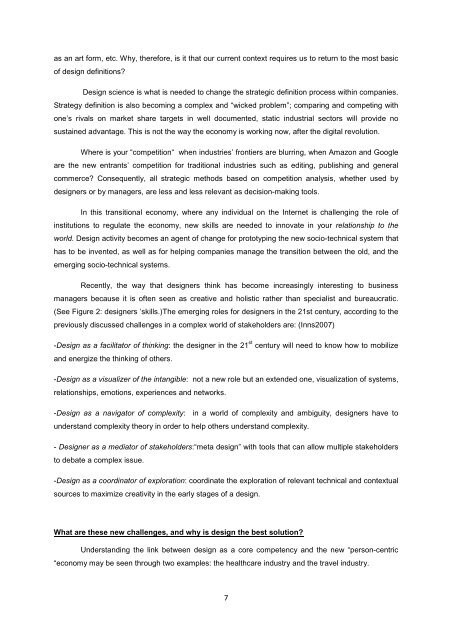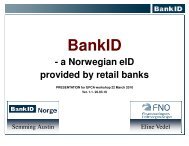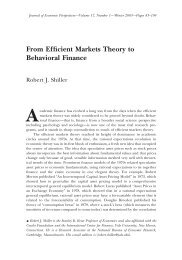Design Management as core competency
Design Management as core competency
Design Management as core competency
You also want an ePaper? Increase the reach of your titles
YUMPU automatically turns print PDFs into web optimized ePapers that Google loves.
<strong>as</strong> an art form, etc. Why, therefore, is it that our current context requires us to return to the most b<strong>as</strong>ic<br />
of design definitions<br />
<strong>Design</strong> science is what is needed to change the strategic definition process within companies.<br />
Strategy definition is also becoming a complex and “wicked problem”; comparing and competing with<br />
one’s rivals on market share targets in well documented, static industrial sectors will provide no<br />
sustained advantage. This is not the way the economy is working now, after the digital revolution.<br />
Where is your “competition“ when industries’ frontiers are blurring, when Amazon and Google<br />
are the new entrants’ competition for traditional industries such <strong>as</strong> editing, publishing and general<br />
commerce Consequently, all strategic methods b<strong>as</strong>ed on competition analysis, whether used by<br />
designers or by managers, are less and less relevant <strong>as</strong> decision-making tools.<br />
In this transitional economy, where any individual on the Internet is challenging the role of<br />
institutions to regulate the economy, new skills are needed to innovate in your relationship to the<br />
world. <strong>Design</strong> activity becomes an agent of change for prototyping the new socio-technical system that<br />
h<strong>as</strong> to be invented, <strong>as</strong> well <strong>as</strong> for helping companies manage the transition between the old, and the<br />
emerging socio-technical systems.<br />
Recently, the way that designers think h<strong>as</strong> become incre<strong>as</strong>ingly interesting to business<br />
managers because it is often seen <strong>as</strong> creative and holistic rather than specialist and bureaucratic.<br />
(See Figure 2: designers ’skills.)The emerging roles for designers in the 21st century, according to the<br />
previously discussed challenges in a complex world of stakeholders are: (Inns2007)<br />
-<strong>Design</strong> <strong>as</strong> a facilitator of thinking: the designer in the 21 st century will need to know how to mobilize<br />
and energize the thinking of others.<br />
-<strong>Design</strong> <strong>as</strong> a visualizer of the intangible: not a new role but an extended one, visualization of systems,<br />
relationships, emotions, experiences and networks.<br />
-<strong>Design</strong> <strong>as</strong> a navigator of complexity: in a world of complexity and ambiguity, designers have to<br />
understand complexity theory in order to help others understand complexity.<br />
- <strong>Design</strong>er <strong>as</strong> a mediator of stakeholders:“meta design” with tools that can allow multiple stakeholders<br />
to debate a complex issue.<br />
-<strong>Design</strong> <strong>as</strong> a coordinator of exploration: coordinate the exploration of relevant technical and contextual<br />
sources to maximize creativity in the early stages of a design.<br />
What are these new challenges, and why is design the best solution<br />
Understanding the link between design <strong>as</strong> a <strong>core</strong> <strong>competency</strong> and the new “person-centric<br />
“economy may be seen through two examples: the healthcare industry and the travel industry.<br />
7
















